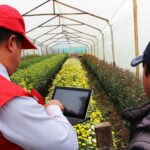Humanizing technology, a challenge for microfinance
Thirty years ago, microfinance revolutionized the market with affordable loans for the disadvantaged. Until then, the most vulnerable population segments were left out on the fringes of the financial system, and had no way of accessing credit. Today, with 2 billion adults still unbanked, new technologies are emerging with the potential to reach more people at a lower cost. But this opportunity is having a challenging impact on the current microfinance model, which was built on the pillars of personal relations and trust.

Blockchain is of the most disruptive –and talked about– technologies in the banking sector. According to BBVA Research, blockchain is a “public ledger supported by a distributed network of computers that does not require any central authority or third party to act as intermediaries.” During the European Microfinance Summit, which recently took place in Barcelona, CEO Bitbond Radoslav Albrecht explained some of its advantages, including increased reliability, cost effectiveness, efficiency and universality compared to current digital banking methods.
"The technological and innovation solutions that we are developing seek to build stronger and more efficient personal ties
Precisely, in the near future, one of the more pressing challenges for microfinance institutions that base their success on human relations with customers, will be figuring out how to leverage new technologies to communicate better with customers. According to Giovanni di Plácido, Head of Analysis and Studies at the BBVA Microfinance Foundation (BBVAMF): “Far from overlooking human relations, the technological and innovation solutions that we are developing seek to build stronger and more efficient personal ties.”
The foundation’s advisors are bringing technologies to some of the most remote locations in Latin America to allow entrepreneurs to become acquainted with these new management tools and, little by little, start using them in their financial operations.

The BBVAMF advisors are bringing technologies to some of the most remote locations in Latin America - BBVA Microfinance Foundation
New technologies, an opportunity to prevent over-indebtedness
Countries with high financial exclusion indexes, such as Peru (over 71%, according to the latest figures published by Global Findex), over-indebtedness in metropolitan areas coexists with huge segments of the population that cannot gain access to the financial system. This paradox is, so to speak, a distinctive feature of all developing countries share, as Perrine Pouget, Investment Officer at European Investment Bank (EIB) pointed out in Barcelona.
According to Pouget, risk prevention is vital to avoid market saturation. In fact, the consequences over-indebtedness have a tremendous impact on the reputation of microfinance institutions, which are, for many, the only way they can gain access to the financial system. Pouget continued stressing the importance of protecting the customer, not only because it is the “right thing to do”, but because it is also the “smartest thing to do:” “Increasing protection for customers who are having trouble meeting their debt payments, will allow improving risk management and product quality at microfinance institutions,” he noted.
"We need to promote the next wave of innovation that will allow us to reach places that we haven’t been able to reach yet
For Claudio González-Vega, chairman of the Board of Trustees of the BBVA Microfinance Foundation, solving this paradox should allow to make progress in improving financial inclusion levels: “We need to streamline the institutional, regulatory and technological mechanisms to reduce the incidence of over-indebtedness; and, on the other hand, we need to promote the next wave of innovation that will allow us to reach places that we haven’t been able to reach yet.”

A BBVAMF advisor visits an entrepreneur in Colombia - BBVA Microfinance Foundation
Generating social impact through microfinance
During the EMS, Luca Torre, CEO and co-founder of GAWA Capital, discussed some of the reasons for investing in a sector with such a high social impact such as the microfinance sector. According to him, productive microcredits, which promote the creation and development of micro-businesses, contribute to the growth of domestic economies and help make significant progress towards curbing poverty. Also, he noted how is important it is to accompany these products with other products such as savings and microinsurance.
Precisely, this is the model that has allowed the BBVA Microfinance Foundation to provide support to 1.8 million entrepreneurs from disadvantaged segments of society, with a measurable social impact. According to Rodrigo Peláez, head of Impact Measurement at BBVAFM, the assessment of entrepreneur and businesses progress is seen as a management tool. “Measuring the economic and social impact of our customers helps us better understand their situation and verify if our work is aligned with our mission,” he said during the European Microfinance Summit.
“The Foundation has been creating opportunities for ten years now – said the Chairman of its Board of Trustees – and today, in the new digital era, it is committed to promoting innovation as a way to reach out to those who, in the most remote parts of the planet, have been denied of a better future.”